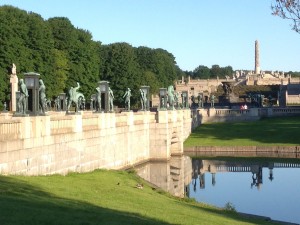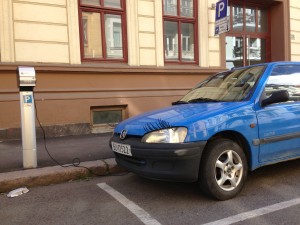Day 1 in Oslo began on foot, getting my bearings on an early morning walk past neat houses nestled into the undulating hills around the harbour.
I soon found myself pondering the human condition on a bridge over Frogner-dammen, face to face with sculptures by Gustav Vigeland (1869-1943) that display the full range of our capacity for love, tenderness, anger, cruelty, compassion, friendship, family loyalty.
The power of human emotions was a recurring theme that afternoon, with the first conference session on “Extreme Dialogue on Climate Extremes – Building a Bridge to the Future” in the expert hands of Nisha Pillai, former anchor of BBC World News.
To set the scene, a few selected participants shared their vision of what future “climate extremes” looked like from their perspectives:

Sculptures by Gustav Vigeland (1869-1943) that display the full range of our capacity for love, tenderness, anger, cruelty, compassion, friendship, family loyalty
Nnimmo Basey spoke of Nigeria, sandwiched between the Sahara and the Atlantic. In the north, the rivers had run dry and his savannah homeland was covered in sand-dunes. In the south, oil spills gushing from the Niger Delta had spread everywhere, killing fish and crabs across estuaries and mangroves while the land retreated under attack from the sea. His views were not respected at the political level and he had to survive by his wits.
Madeleen Heyland, from the Red Cross in the Netherlands, spoke of a 1987 Pacific Island Monthly article “Saying goodbye to Kiribati and Tuvalu” that painted the situation facing small island states a generation ago. By 2007, some believed we have to give up on the atolls, given the now very real possibility that they will disappear beneath the waves. It is not an academic exercise for her Polynesian students in Montpellier, who tell her perhaps their people “will have to sail on again if our islands vanish”.
Mehjabeen Abidi Habib spoke of Pakistan’s vulnerability, her large dry country sustained by the waters locked up in the “third pole”, the glaciers of the Himalayas and the high Karakoram. The Indus River feeds 180 million people spread from its headwaters to the mangroves on the Atlantic, in a human civilization governed by the behaviour of water for over 5,000 years. Water now descends in sudden deluges, with unexpected sea surges wreaking havoc and causing traditional fisher-folk trauma and the loss of boats and their livelihoods.
Horvaad Stensvand brought us back to Norway, speaking of the Dagma storm that broke on the first day of Christmas in 2011. Within 3-4 minutes, the entire community lost electricity and phones and almost all the roads were closed. As County Governor of Sogn og Fjordane, he was proud that people took it calmly, there was little panic and people did what they could to help each other. His challenge was how to meet his responsibility of keeping people informed with none of the usual communication channels functioning.

Electric cars, buses and trucks – like this little charmer – powered from renewable energy, can make a huge reduction in transport emissions.
These small vignettes, and many more viewpoints shared over the next three hours, led to some deep thinking about how we can more effectively grapple with the threat to us all posed by unchecked climate change.
It is clear that we cannot remain stuck with “business as usual” … the world needs rapid progress on climate solutions, at the same time that many people in the community have switched off, whether out of denial or a sense of helplessness.
Part of the answer remains simple – keep true to high ideals, draw inspiration from the bravery of individuals and human creativity and keep democracy alive.
Value local voices and local stories and create narratives of hope, paving combined visions for the future from our discrete views. Work together to focus our actions and make sure, whatever we do, that the sum total of our successes add up to a world that doesn’t heat up any more than 2 degrees Celsius – ever.
The final words were a valuable challenge to us all:
“Meet with your neighbour, and discuss the future that you want”.

Pingback: Climb It for Climate - Everest - Stage 1 | Blog - New Internationalist AustraliaBlog – New Internationalist Australia